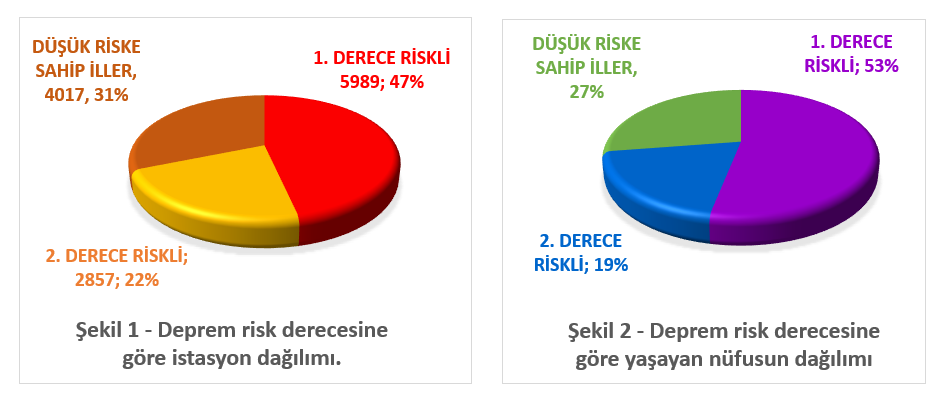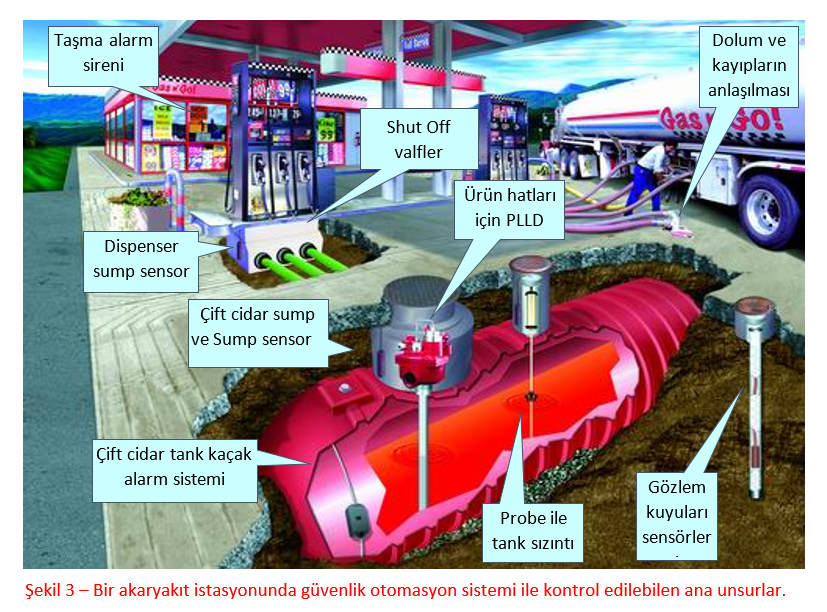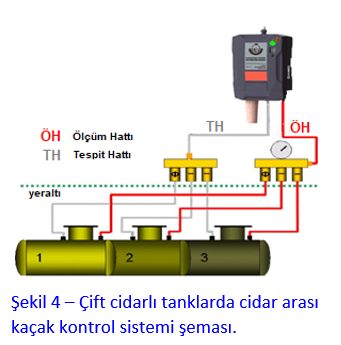20.12.2019 Kocaeli
WHEN TALKING ABOUT BIG EARTHQUAKES, HOW READY ARE GAS STATIONS FOR EARTHQUAKES?
After the recent 5.8 magnitude earthquake off the coast of Silivri, Istanbul, the “Earthquake“, which has not been on our agenda for a while, has suddenly become the center of our lives and agenda again. The fear experienced by people at the time of the earthquake was replaced by an atmosphere of panic after the earthquake.
Especially collapsed communication lines and people who cannot communicate with each other with their children at school and their relatives at home with great haste., In short, they tried to reach their loved ones and GSM lines, internet infrastructure, fixed phones, mobile applications and Istanbul traffic, which was already quite busy, gave a very difficult test. Together, we saw that, Unfortunately, in the 20 years that have passed since the great Marmara earthquake of 1999, not much progress has been made in terms of earthquakes in terms of both infrastructure and public awareness.
The former director of the Kandilli Observatory, the late Ahmet Mete Işıkara, used to say, “Earthquakes don’t kill, rotten buildings do.” According to this very accurate determination, the most basic way to protect against earthquakes is to build buildings in accordance with standards that take into account the risk of earthquakes. Naturally, the same path should be followed for industrial establishments working with hazardous substances and especially for gas stations. In addition to the structural strength of the industrial establishments located in the earthquake zone, their mechanical, electrical, flow, etc. The robustness of their infrastructure is equally important. If it is remembered, after the great Marmara earthquake, there were very dangerous accidents, especially in some industrial establishments in the Kocaeli region. In the most striking of these accidents,
- 6500 tons of acrylonitrile escaped into the air, water, and soil through cracks in storage tanks;
- 200 tons of anhydrous ammonia were released into the air due to excessive pressure rise;
- 50 tons of diesel fuel spilled into the Gulf of Izmit due to the breakdown of the fuel loading arm;
- 1200 tons of cryogenic (supercooled liquefied) oxygen was discharged from the two oxygen storage tanks, which were split by the collapse of the concrete support columns;
- Major fires broke out in the TÜPRAŞ oil refinery, which took four days to extinguish, LPG (liquefied petroleum gas) leaked into the air and oil spilled into the environment;
- Only 58 workplaces in the Kocaeli region and more than 350 large and medium-sized enterprises around the Gulf of Izmit were significantly damaged, and the local municipality informed that many of these workplaces had heavy damage and chemical leaks.
If we look at the issue from the point of view of gas stations, we immediately come across the 5.0 magnitude Muş earthquake in 2002, an explosion at the gas station 5 km away from the city center, and as a result, a fire that was tried to be extinguished for a long time. Although the city center and the area around the station were not damaged much by the earthquake, this explosion and the fire it caused caused much higher damage around the station than the earthquake.
Therefore, if the necessary precautions are not taken at the fuel and service stations located near the center of the cities with high earthquake risk, much more than the damage caused by the earthquake and the burning effects may be encountered, as in the case of the Muş earthquake. For this reason, it is very important to take additional and specific measures at fuel and service stations in cities with high earthquake risk.
According to the earthquake risk map of Turkey published by AFAD 1. and The distribution of fuel stations and population in provinces with 2nd degree earthquake risk is shown in two circular graphs in Figure 1 and Figure 2, respectively. These graphs clearly reveal the magnitude of the potential danger.

For additional and specific measures that can be taken against earthquakes at fuel and service stations, additional measures can be introduced for stations with a high risk of earthquake damage in TS 12820, which primarily determines the safety standards at these stations. The first factors to be considered in this regard are fuel storage tanks and related mechanical, electrical, and flow installations.
In such stations, the capacities and numbers of underground storage tanks can be determined according to the results of the ground survey, and different and more protective standards can be applied in the construction techniques of structures such as tank pools and canopies. The use of elastic flexible (filament) pipes can be encouraged or made mandatory in fuel oil and LPG/gas installations that move under the effects of the forces created by seismic movements and enter voltage.
In addition, the installation of seismic motion-driven power cut-off systems at stations located in areas with high earthquake risk will ensure that the energy flow and therefore the fuel supply are automatically stopped in the event of an earthquake, and will reduce the risks of fire and explosion that may occur after an earthquake.
The measures proposed so far and the equipment and installations are aimed at protecting the fuel and service stations and their immediate surroundings, especiallyat the time of prem, and can be added during the construction phase of the stations or in their current condition.
A separate issue of equal importance is whatmeasures should be taken into accountfor the post-election period. As it is known, fuel and service stations are turning into an environment where people can meet their very different daily needs and use them as a meeting point, beyond just meeting the fuel needs of the society. Therefore, after a natural disaster such as an earthquake, it is clear that these stations will play a very important role such as meeting the urgent needs of people and even being used as a meeting or gathering area.
Although there is no visible physical damage after the earthquake in these places, where many of these services are provided 24/7, it should be ensured that all underground installations and the system in general work effectively, faultlessly and safely. It should not be forgotten that the inspection to be carried out for this purpose only by looking at the general appearance of the facility may cause some unsafe situations in the ongoing activities and as a result, serious large-scale problems may arise.
Since everyone will be mobilized to be in a safe environment with their families after a severe earthquake, it will be very difficult to find sufficient technical staff and equipment to carry out the necessary checks mentioned above; Existing or existing elements may have been shocked or are going through shock in an environment of confusion and will be unable to work. In such cases, the importance of the design, construction and material quality of the safety equipment installed at the stations will emerge.
In this case, the first question that will come to mind is, “Can I control my station without needing anyone?” In fact, the schematic picture shown in Figure 3 gives a clear answer to this: “Of course, YES.”
If the stations are built in accordance with the relevant standards and all the systems and safety equipment used are installed using the necessary design, construction and materials, it is possible to control the entire area of the station, including underground storage tanks and infrastructure, in a short time without the need for anyone in case of an emergency.

Here are some useful things to know about the systems that will be primarily checked after a natural disaster at a fuel and service station.
Infrastructure pipes: EN 14125 certified flexible plastic pipelines and fittings installed underground are highly resistant to seismic movements and have a long life.
Product lines: with the electronic pressure lines leak detector (PLLD) system, after the most sensitive test lasting about 1.5 hours, it detects whether there is a leak of more than 0.38 liters in the product line in a time frame of 1 hour. An example to grasp the importance of this precise measurement is that the mechanical leak detectors used twenty years ago could only detect leaks larger than 11.4 liters per hour, causing thousands of liters of product to flow from the product lines to the ground for days after the 1999 earthquake.
Filling lines: the filling lines of a station consist of double-walled pipes, allowing easy and precise leak control in the filling installation between the filling point and the tanks. If the lines in question do not consist of double-walled pipes, another and practical way to understand whether there is a product loss after an emergency is to fill a certain amount of product into the tank and compare it with the amount of increase through the automation system.
Shut Off Valves: These products, also referred to as emergency shut-off valves, must be TS EN 13617-3 certified. These valves have a melt-type latch mechanism that will close the flow when exposed to fire. In addition, they have a mechanism to prevent liquid discharge on both sides of the breaking point by breaking safely in the event that the dispenser receives a serious impact, is dragged or overturned as a result of such an impact. It is vital that these equipment are approved products and installed in accordance with the manufacturer’s instructions.
Observation wells: Thanks to the sensors placed in the observation well, which must be installed in the pool in which the underground storage tanks are located (at least one), it is possible to immediately detect the fuel oil or groundwater that may accumulate there.
Fuel tanks: if an underground storage tank isdouble-walled , but is not equipped with  an EN 13160 certified inter-wall leakage control system similar to the one shown in Figure 4, then it is not possible to keep the tank under control with a continuous test and to generate a warning alarm in case of leakage or leakage. Therefore, it is strongly recommended to equip double-walled underground storage tanks with an EN 13160 certified inter-wall leakage control system in order to provide protection and protection at all times and under all risk conditions.
an EN 13160 certified inter-wall leakage control system similar to the one shown in Figure 4, then it is not possible to keep the tank under control with a continuous test and to generate a warning alarm in case of leakage or leakage. Therefore, it is strongly recommended to equip double-walled underground storage tanks with an EN 13160 certified inter-wall leakage control system in order to provide protection and protection at all times and under all risk conditions.
If an underground storage tank is single-walled, how can leaks and leaks be detected? It may be possible to perform this process with the “Tank Automation System” being used. However, this system in use must have leak detection capability and certification. A tank automation system of this nature makes it possible to detect an ongoing leak or leak from an underground storage tank with a flow rate of 0.38 liters or more in 2 (two) hours.
FiberGlass or Polyethylene Dispenser/Tank Sumps: These sumps, which are applied under the dispenser and on the tank, prevent groundwater from entering these areas. It will prevent the spread of fuel spills that may occur on the tank or under the dispenser and prevent them from spreading to the soil. During the seismic movements that will be experienced in the earthquake, especially sumps made of double-walled fiberglass material are very durable and long-lasting products that enable these functions to continue. Only these sumps are models that are suitable for leak testing. As shown in Figure 3, dispensers and tank sumps in the entire field can be controlled from a single point.
Tora With more than 20 years of experience in the sector, Petrol has been implementing all these systems for years, introducing them to its stakeholders in the sector and striving to ensure that they are not harmed not only in days of peace and tranquility, but also in days of emergency and disaster. Immediately after the 1999 great Marmara earthquake, Tora Petrol comprehensively inspected all mechanical infrastructure and storage tanks at approximately 400 stations.
Therefore, when Tora’s quality in infrastructure piping and fuel systems is combined with Gilbarco Veeer Root automation and environmental sensor applications, it is possible to achieve the convenience of controlling a fuel and service station at any time and under any condition without being dependent on anyone.
For detailed information, you can reach our 24/7 Tora Petrol Call Center at 0850 222 87 22 or write to us at www.torapetrol.com.
